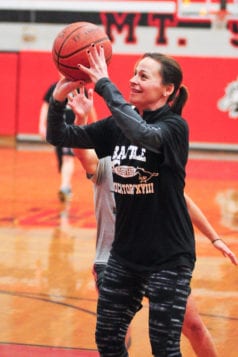By Daniel Dunaief
This is the second half of a two-part series on autism research conducted by Hyunsik Kim and Erin Kang.
Last week we focused on the work of Stony Brook University graduate student Hyunsik Kim, who used three criteria to diagnose autism. This week we will feature the work of another SBU graduate student in the Department of Psychology, Erin Kang, who specifically explored the types and severity of communication difficulties autistic children have.
Words and the way people use them can offer clues about autism. Looking closely at pronoun reversals, speech delays, perseveration and 10 other characteristics, Kang determined that the number of features was a “powerful predictor of an autism spectrum disorder diagnosis.”
In a paper published online in the Journal of Clinical Child & Adolescent Psychology, Kang grouped children from 6 to 18 years old into different subgroups based on their communication patterns and used a statistical method that allows the data to “speak for itself,” in terms of finding groups based on the patterns of how the communication difficulties are associated and to classify them.
According to Kang, heterogeneity is an important feature of autism spectrum disorder. “There has been a greater effort into understanding whether subgroups exist in ASD populations,” she explained in an email. By examining the atypical communication characteristics, she found four subgroups. These groups differed from each other, not only with autism, but on multiple measures, including the occurrence of anxiety or depression and with intellectual disabilities.
The communication difficulties occur at different rates within the autism children throughout Long Island that Kang studied.
Kang said her work has been “building on the previous literature,” although many of the previous studies focused on characterizing autism for children who were younger than 6.
“There are few studies on specific symptoms (e.g., stereotyped speech) across the body of literature,” she explained, adding that she’s passionate about exploring the trajectory of development over time with or without intervention.
She and her co-authors, Ken Gadow and Matthew Lerner, who are also at Stony Brook University, are working on a follow-up paper that attempts to explore how changes in the pattern of communication challenges examined in the paper relate to other clinical aspects and outcomes.
Kang believes her results have clinical implications that will help in understanding autism. Atypical communication features are a good predictor of diagnostic status. “This can provide an advantage in assessing social communication profiles in autism,” she said. “It’s hopefully valuable in a low-resource setting.”
Parents might be asked 13 questions on a checklist, which could serve as an initial screening for more comprehensive autism evaluations, rather than a multiple checklist that could take a while for parents to complete. The different categories had specific features that distinguished them.
“There’s been quite a bit of work in the speech and language field,” said Lerner, an associate professor of psychology, psychiatry and pediatrics in the Department of Psychology at Stony Brook University and Kang’s mentor. “This approach allowed us to ask about some of the specific types of language differences we often see.”
Lerner said what Kang found is that specific characteristics do tend to cluster together in “interesting and unique ways that can tell us more about the communicative phenotype of autism.”
One of the groups, which she called “little professors,” had speech patterns with considerable perseveration. In perseveration, a person repeats a word or phrase, even when a question or stimulus that might elicit that phrase no longer continues. As an example, Dustin Hoffman in the movie “Rain Man” frequently repeated the number of minutes until Judge Wapner was on TV.
“These kids would benefit more from a group-based social skills intervention that specifically integrated interacting with peers,” Kang said. People in this group had the highest percentage of wanting a friend, but difficulty with relating to peers.
“They will benefit especially from interventions that help them build skills in interacting with peers,” she explained.
She also suggested that the best way to make a reliable diagnosis is to collect as much information as possible, which could include observations and electrophysiological data.
Kang acknowledged that some of the responses from the parents or teachers of people with autism contain bias. “There can be a lot of potential especially in terms of these subjective measures,” she said.
Indeed, through Lerner’s lab, Kang has been trying to include more uses of neurological measures and other methodology that is less subject to biases.
“Hopefully, by looking at these more objective measures, we can help integrate information from these different levels,” she said.
A resident of East Northport, Kang lives with her husband, musician Sungwon Kim, who works as a freelancer on Broadway musicals. The couple, who have a young son, met in Boston when she was working at Boston Children’s Hospital and he was a student at Berklee College of Music.
Kang’s first experience with autism was in high school, when she acted as a mentor to a second grader. When she entered college at the University of California at Berkeley, she studied molecular and cellular biology and psychology.
Lerner said that Kang is a “truly remarkable young scholar” and is “among the best I’ve seen at her stage to be able to look at her clinical experiences, which drive the questions that strike at the core of how we understand and treat autism.”
Lerner appreciates how she is driven to understand autism from neurons in the brain all the way up to the classification and treatment.
“She is somebody who is completely undaunted by taking on new questions or methodologies because she has an idea of what they’re going to mean,” Lerner said. “She has worked with [autistic children] and has tried to understand where they are coming from.”
Kang questions assumptions about what autism is, while also exploring its development.
“She is able to see and discover clinical strengths that manifest in the kinds of questions she asks,” explained Lerner. “She is a part of the next generation of where my field is going, and I hope we can catch up to her.”
Kang appreciates the work-life balance she has struck on Long Island, where she feels like the pace of life is “quiet and calm during the week,” while it’s close enough to New York City to enjoy the cultural opportunities.
























































